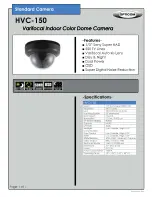
DSP-22-1 User Manual
Page 9 of 22
DSP-22-1_MAN_D
When Channel 1 is in the pulse mode of operation, the pulse generated by the output will be 250 milliseconds
long. There are slight differences between the probe pulse mode (DIP switch 5 ON) and the pulse mode (DIP
switch 4 ON). So, they will be explained individually.
If DIP switch 4 is ON and DIP switch 5 is OFF, the way the pulse mode operates is commonly referred to as Pulse
on Entry. In Pulse on Entry mode, the Channel 1 Output will pulse when a vehicle first enters the loop. The output
will not pulse again until the vehicle has vacated the loop. After the pulse has been output, the Detect 1 LED will
flicker (a very fast flash that is not at full brightness). This is a visual indication that the pulse has already been
output but the loop is still occupied, and no further pulses can be output until the loop is no longer occupied.
If DIP switch 5 is ON, the way the pulse mode operates is commonly referred to as Pulse with a 1 second retune.
In this mode, the Channel 1 Output will pulse when a vehicle first enters the loop. The channel will then wait 1
seconds and retune (reset) that channel. In the probe mode of operation, the detector will only hold a detection
for 1 second. Therefore, if a vehicle stays over the probe for more than 1 second it may generate additional pulses
for the same vehicle.
DIP
Switch 4
Function
OFF
Channel 1 Presence Mode
ON
Channel 1 Pulse Mode
Channel 1
–
Loop / Probe (DIP Switch 5)
The DSP-22-1 is capable of operating with either a standard inductive loop or the new free-exit probe
(magnetometer). As usual, the inductive loop operates in both presence and pulse modes. However, the free-
exit probe (magnetometer) can only operate in pulse mode and will automatically override any settings to the
contrary. The factory default is the inductive loop mode.
DIP
Switch 5
Sensor Type
OFF
Channel 1 Inductive Loop
ON
Channel 1 Free-Exit Probe
NOTE:
In the probe mode of operation the detector will only hold a detection for 1 second. Therefore, if a vehicle
stays over the sensor for more than 1 second it may generate additional pulses for the same vehicle.
Indicators
The DSP-22-1 is equipped with two (2) LED indicators: Power (Green) and Detect 1 (Red).
Power LED
–
The green power LED indicates these possible states:
Off
The voltage applied to the detector is less than the minimum display
voltage of approximately 3 volts. The LED will be off.








































